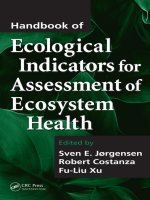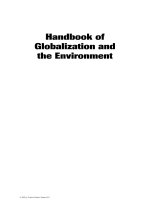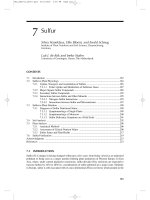Handbook of Ecological Indicators for Assessment of Ecosystem Health - Chapter 7 doc
Bạn đang xem bản rút gọn của tài liệu. Xem và tải ngay bản đầy đủ của tài liệu tại đây (499.22 KB, 8 trang )
CHAPTER 7
Application of Ecological and
Thermodynamic Indicators for the
Assessment of the Ecosystem
Health of Coastal Areas
S.E. Jørgensen
Six ecological indica tors, taken from Odum’s attributes (1969, 1971), and
5 thermodynamic indicators were studied in 12 coastal ecosystems. The
correlations among the 11 indicators were examined, and the extent to which
the 5 thermodynamic indicators: exergy, exergy destruction, exergy produc-
tion, exergy destruction/exergy, and specific exergy, can be applied to assess
ecosystem health was discussed. It can be concluded that the thermodynamic
indicators cover a range of important properties of ecosystems and correlate
well with several of Odum’s attributes, which are widely applied as ecological
indicators. To give a sufficiently comprehensive assessment of ecosystem health
for environmental management, however, will probably require other
indicators in ad dition to the thermo dynamic indicators.
Copyright © 2005 by Taylor & Francis
7.1 INTRODUCTION
This chapter presents the results of a study in which several ecological
indicators (including recently proposed thermodynami c indicators, exergy,
exergy destruction, exergy destruction/exergy, exergy production increase in
exergy, and specific exergy) were applied to 12 coastal ecosystems (described in
detail by Christensen and Pauly, 1993). The extent to which the ecological
indicators are correlated with the thermodynamic indicators will be explained.
A recommendation on the application of thermodynamic indicators for the
assessment of ecosystem health in environmental management can probably
be derived from these results. Figure 7.1 gives an example of the steady -state
models available for all 12 case studies.
7.2 RESULTS
The 12 ecosyst ems are:
1. Tamaihua, a Coastal Lagoon in Mexico
2. Celestun Lagoon, southern Gulf of Mexico
3. A coastal fish community in southwestern Gulf of Mexico
4. The Campeche Bank, Mexico
5. The Maputo Bay, Mozambique
6. A Mediterranean lagoon: Etang de Tahu, France
7. Pangasinan coral reef, Philippines
Figure 7.1 Flow diagram of the fish community of Tamiahua Lagoon, Mexico. The diagram
indicates the results by use of ECOPATH II in g/m
2
for biomasses and in g/m
2
/year
for rates.
Copyright © 2005 by Taylor & Francis
8. Caribbean coral reef
9. Yucatan Shelf Ecosystem, Mexico
10. Continental Shelf Ecosystem, Mexico
11. Shelf Ecosystem, Venezuela
12. Brunei Darassulak, South China Sea.
The following ecological indicators were determined for all 12
ecosystems:
Biomass (g dry weight/m
2
)
Respiration (g dry weight/m
2
y)
Exergy (kJ/m
2
)
Exergy destruction (kJ/m
2
/year)
Diversity as number of species included in the model (—)
Connectivity as number of connections relatively to the total number of
possible connections (—)
Complexity expressed as ‘‘diversity’’ times ‘‘connectivity’’ (—)
Respiration/biomass ¼ B/A (year À 1)
Exergy destruction/exergy ¼ D/C (year À 1) Jørgensen (2002)
Exergy production (kJ/m
2
/year) Jørgensen (2002)
Specific exergy (kJ/g) Jørgensen (2002).
Using a correlation matrix it was found that only the following of the 11
indicators were correlated with a correlation coefficient ! 0.64:
Exergy production to exergy, R
2
¼ 0.93, see Figure 7.2.
Respiration to exergy, R
2
¼ 0.98, see Figure 7.3.
Respiration to biomass, R
2
¼ 0.68, see Figure 7.4. Notice in this context
that respiration is considerably better correlated to exergy than to
biomass.
Respiration to exergy production, R
2
¼ 0.855, see Figure 7.5.
Figure 7.2 Exergy production plotted against exergy.
Copyright © 2005 by Taylor & Francis
Exergy destruction to respiration, R
2
¼ 0.87 see Figure 7.6.
Respiration/biomass to specific exergy, R
2
¼ 0.86, see Figure 7.7.
Respiratory to exergy dissipation or destruction, R
2
¼ 0.86, see Figure 7.8.
7.3 DISCUSSION
Higher exergy levels are, at least for the examined marine ecosystems,
associated with higher rates of exergy production which is consistent with the
Figure 7.4 Respiration plotted against biomass. Notice that the correlation in Figure 7.3 is
considerably better than this correlation.
Figure 7.3 Respiration plotted against exergy.
Copyright © 2005 by Taylor & Francis
translation of Darwin’s theory to thermodynamics by the use of exergy. As an
ecosystem develops, its biomass increases, and when all the inorganic matter is
used to build biomass, a reallocation of the matter in form of species with more
information may take place. Increased information gives increased possibility
to build even more exergy (information).
The respi ration levels for the various examined ecosystems are considerably
better correlated with the exergy levels than with the amount of biomass in the
examined ecosystems, although there is a tendency slope respiration/exergy to
decrease as exergy increases (as shown in Figure 7.3). This tendency cannot be
Figure 7.6 Exergy dissipation plotted against respiration.
Figure 7.5 Respiration plotted against exergy production (increase in exergy storage).
Copyright © 2005 by Taylor & Francis
shown to be statistically significant as it woul d require information from more
marine ecosystems.
Biomass includes plants (algae) that have relatively low exergy and also
lower respiration. It explains why exergy with high weighting factors for fish
and other higher organisms is better correlated with respiration than biomass
(see Figures 7.3 and 7.4). The relationship is not surprising, as more stored
exergy means that the ecosystem becomes more complex and more developed,
which implies that it also requires more energy (exergy) for maintenance. More
developed ecosystems also mean that bigger and more complex organisms
become more dominant. As bigger organisms have less respiration relative to
the biomass (according to the allometric principles), it is not surprising that the
ratio of respiration to exergy (the slope of the plot in Figure 7.3) decreases with
Figure 7.8 Respiration is plotted versus exergy dissipation (or destruction).
Figure 7.7 Respiration/Biomass plotted against specific exergy.
Copyright © 2005 by Taylor & Francis
increasing exergy. These results are also inconsistent with Figure 7.5, where
respiration is well correlated with exergy production. A high respiration level is
associated with higher organisms with more information, which again gives the
opportunity to increase the information further.
The correlation between the respiration level and the rate of exergy
destruction in Figure 7.6 is not surprising, as the exergy destruction is caused
by respiration. It is just two sides of the same coin.
Figure 7.7 indicates that the specific exergy for the examined ecosystems —
higher specif ic exergy means more dominance of higher organisms — is well
correlated with the rati o of respiration to biomass, which is also consistent with
the results presented in Figure 7.5.
The results are consistent with the discussion in chapter 2, where the
concepts of exergy-specific exergy were presented and associated with
ecosystem health characteristics:
1. Exergy measures the distance from thermodynamic equilibrium.
Svirezhev (1992) has shown that exergy measures the amount of energy
needed to break down the ecosystem. Exergy is therefore a reasonably
good measure of the following (compare with Costanza, 1992).
a. Absence of disease (may be measured by the growth potential).
b. Stability or resilience (destruction of the ecosystem is more difficult the
more exergy the ecosystem has).
c. Vigor or scope for growth (notice in this context that Figure 7.2 shows
a good correlation between exergy and exergy production [growth]).
2. Specific exergy measures the organization in the sense that more
developed organisms correspond to higher specific exergy. More
developed organisms usually represent higher trophic levels. It implies a
more complicated food web. Specific exergy is a therefore a reasonably
good measure of:
a. Homeostasis (more feed back is present in a more complicated food
web)
b. Diversity or complexity
c. Balance between system components — the ecosystem is not
dominated by the first trophic levels as this is usually for ecosystems
at an early stage.
Notice that exergy or specific exergy is not correlated to diversity or
complexity as determined by the connectivity. Complexity of ecosystems has
several dimensions as illustrated by this chapter: complexity due to: (1) the
presence of more complex organisms; (2) diversity; and (3) a more complex
network. These three complexities increase independently of each other.
7.4 CONCLUSIONS
Eleven ecological and thermo dynamic indicators were examined for 12
marine ecosystems. The results showed that a good correlation could only be
Copyright © 2005 by Taylor & Francis
obtained for the following pairs: exergy/exergy production, exergy/respiration,
biomass/respiration, exergy production/respiration, respiration/exergy dissipa-
tion, specific exergy/respiration/biomass.
It was discussed that exergy and specific exergy and the other three
thermodynamic indicators together cover the prop erties normally associated
with ecosystem health (Costanza, 1992). It is probably not possible to assess
the health of such a complex system as an ecosystem by means of only two to
five indicators, which is also consistent with the lack of correlation between
these two concepts and the other attributes included in this examination. It can,
however, be assessed that exergy is a good measure of the ability of the
ecosystem to grow (see Figure 7.2). Exergy is also a good measure of the energy
(exergy) required for maintenance — better than biomass on its own — as
more stored exergy and higher exergy production mean that more exergy is
also needed for maintenance (see Figure 7.3, Figure 7.5 and Figure 7.6).
Exergy or specific exergy is not well correlated with diversity (expressed simply
as the number of state variables in the model) or complexity (measured simply
as the product of number of state variables in the model and the connectivity),
which is consistent with the results of several other chapters in this volume. On
the other hand, specific exergy is a good expression for the presence of more
developed organisms (and a more complex ecosystem).
The two concepts of exergy and specific exergy cover a certain range of
properties that we generally associate with ecosystem health. They should,
however, be supplemented by other indicators in most practical management
situations, as they are not strictly correlated to other important attributes.
REFERENCES
Christensen, V. and Pauly, D. Trophic Models of Aquatic Ecosystems. ICLARM,
Manila, Philippines. 1993, 390 p.
Costanza, R. ‘‘Toward an operational definition of ecosystem health,’’ in Ecosystem
Health, New Goals for Environmental Management, Costanza, R., Norton, B.G.,
and Haskell, B.D., Eds. Island Press. Washington, D.C., 1992, pp. 239–256.
Jørgensen, S.E., Nielsen, S.N., and Mejer, H. Emergy, environ, exergy and ecological
modelling. Ecol. Mod. 77, 99–109, 1995.
Jørgensen, S.E. Integration of Ecosystem Theories: A Pattern 3. Kluwer, Dordrecht,
428 p.
Odum, E.P. The strategy of ecosystem development. Science 164, 262–270, 1069 1969.
Odum, E.P. Fundamentals of Ecology. W.B. Saunders, Philadelphia, 1971.
Svirezhev, Y. Exergy as a measure of the energy needed to decompose an ecosystem.
Presented as a poster at ISEM’s International Conference on State-of-the-Art
of Ecological Modelling, 28, 1992, Kiel.
Copyright © 2005 by Taylor & Francis









